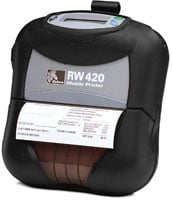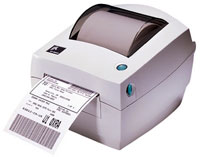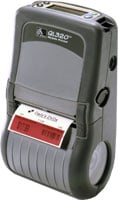Heineken Spain Chooses Zebra For Printing Invoices and Receipts
 The challenge
The challenge
Previously drivers used either handwritten or printed carbon paper forms, making the creation of new documents slow and difficult. This caused a multitude of complaints due to errors or problems reading the documents.
The Objectives
The main purpose of the project was to speed up the distribution process and enable distributors to correct orders when making deliveries, preventing errors when creating the document and during the final invoicing process. In addition, SIH wanted to increase the quality of its printed receipts and invoices printed on mobile printers and reduce the cost of excessive paper consumption.
The Solution
Using Zebra QL 420TM and RW 420TM wireless mobile printers along with Symbol MC9060 terminals, orders can now be corrected during delivery. It is now possible to make changes and print on demand without wasting paper. Thanks to this new process, the distributor now has a record of all the work carried out en route during the course of the day. This is achieved by uploading data to the central system using a Symbol terminal.
Hospital Admissions More Productive, Records More Accurate with Bar Coding
 Challenge:
Challenge:
Provenant Health Partners, a group of affiliated Denver-area hospitals, needed a profitable and reliable system to replace its older card embossing machines. These machines were costly and cumbersome to use. They were also unreliable; imprints of the cards were illegible four to six percent of the time.
Solution:
The hospitals installed Zebra® Stripe® thermal transfer printers to replace the card embossing machines. Hospital employees no longer sent the cards to every department to mark records, but merely printed labels to identify the records of each patient. Bar code labels mark patients’ file folders, order sheets and patient wristbands.
Managing Bar Code Printers Over the Internet
 Viking Direct is a provider of office supplies, based in Germany, which serves the entire European market. It promotes its products through catalogs and the majority of its customers are small and medium sized companies. The company has 600 employees in the German cities of Großostheim and Munich. A third office is scheduled to open in Hamburg later this year. Due to the bar code labeling of products, Viking has been able to meet its ambitious service objectives by delivering products within 24 hours of having received the order.
Viking Direct is a provider of office supplies, based in Germany, which serves the entire European market. It promotes its products through catalogs and the majority of its customers are small and medium sized companies. The company has 600 employees in the German cities of Großostheim and Munich. A third office is scheduled to open in Hamburg later this year. Due to the bar code labeling of products, Viking has been able to meet its ambitious service objectives by delivering products within 24 hours of having received the order.
Previously at Viking
Frank Frost is the IT team leader who provides technical support on a local basis and supervises the work of his six-member team based in Germany, Holland and Belgium. His responsibilities include training employees to manage IT issues and to resolve any problems that may arise locally.
“Viking used to experience difficulties with the bar code printers that were previously in use,†comments Frost. “This was mainly related to the layouts of labels, insufficient print speeds and weak networking capabilities. To add to the matter, all of Viking Direct’s printers are linked to the AS/400 platform, a link that often proved to be difficult to manage.â€
Selection Process
“We started looking for a more effective solution. We sought expert opinion at various trade fair exhibitions and via the Internet,†Frost explains. “One of the most critical issues that we faced was how to access our printers in other regions of Europe or even the world. After all, we were looking to establish one consistent printing environment,†he adds. “Ideally, the new printers that Viking required would have to provide high printing speeds, ease of use and allow operators to enter commands in their own language in order to overcome any possible language barriers.â€
After reviewing many different printers, Viking Direct chose Zebra’s 140XiIII printers because they fulfilled the criteria that Viking required. The integrated Ethernet adapter and user specific selection of languages were particular bonuses. The printers can easily be installed over the Internet and, therefore, be moved from one location to the next without difficulty. They are controlled through the AS/400, whereby label content is generated as a spool file directly from within the platform, forwarded to the printer and then printed on location. In order to reduce network traffic, logos are generally stored locally in each printer and then printed as part of each label.
Mobile Printing Keeps Productivity Percolating at Green Mountain Coffee Roasters
- Forklift-mounted mobile printers cut travel time, reduced labeling errors, and increased throughput in the DC.
- Updated printing operations lowered supply costs.
- Driven natively from within PeopleSoft and other leading ERP software packages, Zebra printers’ ease of integration saves considerable time and costs.
- Four different types of Zebra printers are now used to handle various tasks through- out the company, all sharing a common printer language for ease of support and to share label formats.
- Zebra’s rugged and reliable printers support the broadest range of wireless security standards.
Challenge
Green Mountain Coffee Roasters was named one of America’s “100 Fastest-Growing Small Companies†by FORTUNE Small Business in 2006. The company was growing fast, but its main distribution center in Waterbury, Vt., was not. Green Mountain Coffee Roasters expected the facility to meet its needs for at least six years after it was built, but after three the DC was running at full capacity. The company needed to seek out new ways to make the distribution center more efficient, and to get more out of the capacity it had. Mobile printing was one of the answers to these challenges, making a key process more efficient to help Green Mountain keep up with its growing business.
Green Mountain coffee grew from a local favorite to a successful national brand through its mail-order catalog and Web site. More success followed. Green Mountain coffee is sold nationally under the famous Newman’s Own® Organics brands, and is served in McDonald’s restaurants throughout the Northeast. The company boasts more than 7,000 wholesale customers, was one of the first coffee companies to offer a successful Fair Trade Certified® product line, and ranked No. 1 on Business Ethics magazine’s list of “100 Best Corporate Citizens.â€
In short, Green Mountain coffee is hot. Workload at its central distribution center was overheating. The facility runs three shifts and operates 24 hours a day to ship orders to customers and other distribution centers. The company needed to find new ways to keep up with the growing demand.
Solution
To support the output it needed, Green Mountain decided to increase automation at its main distribution center in Waterbury, Vt. Products are stored in aisles that are each 60 yards long. Material handling systems specialist Diamond Phoenix was contracted to develop a customized warehouse control system (WCS) to integrate with Green Mountain’s legacy enterprise resource planning (ERP) system from PeopleSoft. A Zebra Technologies Premier Partner, recommended new bar code label printers and processes to provide more time savings and efficiency gains.
Incoming Goods Are On the Move with Forklift Mounted Mobile Printers
Challenge:
Moving inventory from dock to stock was a time- consuming, costly process that needed to be improved.
Solution:
Mobile-mounted printers, handheld terminals, and RF data communication enable receiving personnel to process incoming stock and deliver it to inventory.
Product:
Zebra® Encore 4TM mobile printers
As incoming inventory arrives on the receiving dock, it is unloaded onto a forklift. While the goods remain on the forklift, the operator simply keys in to the terminal the product and supplier. The terminal is linked by radio frequency (RF) communication to the automated warehouse host computer. Information on the incoming stock is accessed in seconds. The Zebra Encore 4 mobile thermal printer then prints a routing ticket indicating the specific warehouse location at which the material will be stocked. The operator can then proceed directly to the warehouse location to deliver the material.
MIM labels three times faster with Zebra mobile printers
 Objective:
Objective:
Improve efficiency by enabling store staff to automatically print product labels when handheld terminals display a change of price.
Solution:
The roll-out of 300 QL 220 mobile printers for MIM stores
To boost its efficiency, the MIM chain has just equipped its stores with 300 QL 220 mobile printers. Integrated with the stores IT system, the printers have enabled the company to become more reactive, and store personnel can now do price checking and labeling tasks three times faster than before. MIM is extremely satisfied with this rise in productivity.
Benefits:
Time saved: price labeling is three times faster than the previous solution using a manual labeler.
Reduced risk of errors: data used for label printing is sent directly from the central store system. Staff do not need to enter this information, thereby reducing the risk of error.
Improvements in working conditions: ergonomically designed and very simply to maintain, the PDT and printer combination is easy to use.
Less development needed: implementing the QL 220 and interfacing it with the system, required almost no extra development due to Zebra’s open interfaces.
Mobile printing solution for price mark down labeling sees improved customer service
- Old fashioned manual process of price marks downs.
- How to apply retail price mark downs to only selected clothes items as opposed to whole collections which consisted of several hundred items in store.
- Use of fixed location printers for price mark downs resulted in many financial mistakes being made, not to mention wasted time and resources.
- Use of an external supplier for promotional labels caused delays and errors.
The Solution
- Zebra® QL 320 Plus mobile printers connected to a data terminal using 3rd party software to record stock levels, receipt and delivery of clothing items and price mark down labeling. Continue reading »
Orthopedic Supplies Manufacturer Improves Inventory Control with Bar Codes
 Challenge
Challenge
The company needed to establish a labeling program, and many of DePuy’s distributors and hospitals were implementing automated receiving systems, which required inventory to be bar coded when it reached their receiving docks.
Solution
The system, consisting of 20 on-demand label printers from Zebra Technologies, allowed DePuy to minimize manual data entry, reduce shipping errors, and eliminate the need for costly preprinted forms.
Product
DePuy installed several Zebra® high-performance thermal transfer bar code printers.
On-demand labeling delivers great savings in forms costs by eliminating the need for preprinted forms. Many organizations apply bar coding to improve internal operations, while others adopt the technology to comply with customer or regulatory labeling requirements.
That’s how bar codes came to DePuy Orthepaedics, Inc., an international manufacturer known for its orthopedic products. Implementing bar coding turned out to be a blessing in disguise for DePuy–-they are expecting a $100,000 savings in forms costs alone when all facilities have been converted to the new technology. During the 1980s, DePuy embarked on a plan to widen its distribution channels. Management realized that for the expansion to meet corporate objectives, the company needed to establish a bar code labeling program.
Zebra Mobile Printers Ease Invoicing for Over 2 Million Heating, Water and Electricity Meters
 Unique precision meter-reading system
Unique precision meter-reading system
Brunata A/S uses its own hand-held terminals and the market’s leading portable printers to read two million heating, water and electricity meters a year. Fewer scanning errors, trimmed-down administration and improved customer service are some of the advantages of the new portable scan-print system used by Brunata A/S.
Most work can now be done at the customer’s site
Because the company’s meter readers now use water and heating meters that operate digitally, they are able to complete much of their work at the customer’s premises or home.
The project means that most of all readings are now done by tapping the figures into the handheld terminal. Individual electronic heating meters can be read directly via the terminal. The meter reader can see on the hand-held terminal all the important information for each individual appliance and, in the vast majority of cases, rectify any errors on-site instead of returning to the office and looking up the appliance in the system
Zebra RW420 Mobile Printers Help Ensure Safe Roadways for the Oregon Department of Transportation
 Challenge
Challenge
The Oregon Department of Transportation‘s Governor’s Office of Highway Safety (ODOT) was established in 1969 to provide a safe, efficient transportation system that supports economic opportunity and livable communities for Oregonians. As part of its mission, ODOT is constantly researching innovative technology and the latest trends in transportation to help the organization continue to keep the roads safe for all citizens.
That’s how ODOT discovered the APS PocketCitation software, an innovative electronic citation system from Advanced Public Safety (APS), designed to automate and streamline the process of issuing traffic tickets.
Based in Deerfield Beach, Fla., APS develops innovative technology solutions specifically designed to address the challenges of today’s public safety agencies. It focuses on creating software that operates in conjunction with the mobile computers and handheld devices utilized by law enforcement, corrections, fire and EMS personnel. APS products work with an agency’s existing technology infrastructure to significantly increase officer safety and productivity.
Previously, traffic citations were manually issued by the officer, who was required to write out a multi-part form. There were four colored copies of each citation, with a copy given to each party involved—the officer, violator, court and department of motor vehicles. Although each entity had the same information, the police department, court and motor vehicle bureau had to re-enter the data into their own computer systems before it went on the driver’s record.
“This process was redundant and time consuming,†said Steve Vitolo, program manager of Statewide Law Enforcement and Judicial Programs, Oregon Governor’s Office of Highway Safety.
Problems also occur when the driver can’t read the officer’s handwriting on the ticket. If the defendant cannot read the court date because the print is faded or not easily read, the defendant will fail to attend on the proper court date. The need to write slowly and press hard also increased the time it took for the officer to write each citation.
In addition, there were issues related to officers recording the wrong court date. Police officers—who work from their vehicles—didn’t always have a calendar at their disposal and sometimes wrote court dates on holidays when the court was closed. This would automatically result in a dismissal due to officer error.
Solution
According to Jeffrey D. Rubenstein, founder and CEO of APS, approximately 20 to 30 percent of all hand-written traffic citations are dismissed because of incorrect statute numbers, illegible handwriting and other administrative data errors. PocketCitation’s on-board intelligence solves these problems by ensuring that the citation information entered is correct and that the citation itself is printed in clear, legible type by Zebra RW 420 mobile printers.







